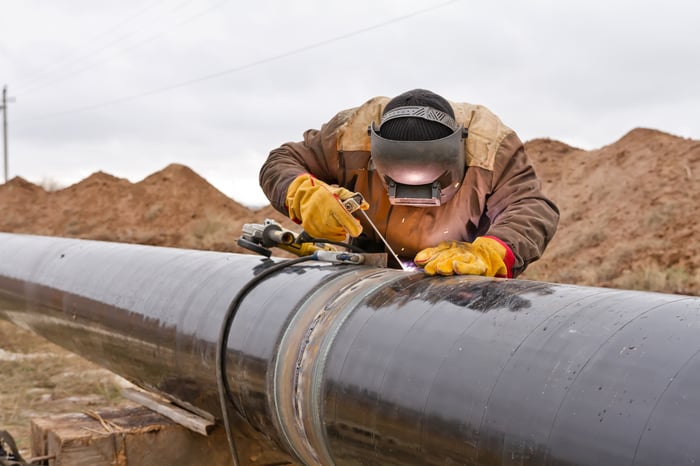I recently added Canadian midstream giant Enbridge (ENB 1.68%) to my portfolio because of its generous and well-supported dividend and efforts to contribute to a cleaner-energy future. But every investment comes with risks, and they need to be considered carefully. So here's a look at the risks that I think are big ones for Enbridge and need to be monitored over time.
1. The obvious one: Carbon
Enbridge has material ties to the carbon-based energy world. There is no way around that fact, with 53% of 2020 EBITDA coming from its oil pipelines, 29% from natural gas pipelines, and 14% from a gas distribution business. While natural gas is likely to increase in importance as the world shifts away from dirtier energy alternatives, like coal and oil, they are still carbon based and definitely not clean energy.

Image source: Getty Images.
Now, to be fair, one of the things I like about this North American midstream giant is its oil and natural gas exposure. I think, as does the company, that carbon energy options are going to be important for a long time and that a slow transition toward clean energy is the right path. In that scenario, Enbridge's vital assets and toll-taker model should be strong performers. However, that doesn't change the big picture, that carbon energy is out of favor. So the key here is that I'm going to keep watching to see that Enbridge continues its shift toward cleaner alternatives (a key reason I bought the stock), which make up just 3% of EBITDA today.
2. Leverage
I've held Enbridge in high regard for a long time, but I didn't buy it. While it was the company's offshore wind power projects and internal solar efforts that helped drive my purchase, one thing I had to get comfortable with was its elevated use of debt. Leverage can limit a company's ability to maneuver right when flexibility is most needed, so this is a very big issue for me. And Enbridge's financial-debt-to-EBITDA ratio has historically been toward the high end of its peer group. That ratio is currently around 6.3 times, much more than that of conservative peers, which sit closer to 4 times.
That said, the utility-like nature of its operations (some of what it owns is, in fact, utilities) provides a solid underpinning for the leverage it uses. And with a distributable cash flow payout ratio target of between 60% and 70%, a range within which it comfortably remains today, it has ample financial leeway before the dividend is at risk. Still, it would be foolish of me to not keep an eye on this issue, though I take additional comfort in the fact that Enbridge managed to take the deep energy downturn in 2020 more or less in stride.
3. Business concentration
The third big risk I see with Enbridge is that a small number of assets account for a material portion of its cash flows. In this case the company's Mainline pipeline system is the big Kahuna. Mainline basically runs from the Canadian oil sands right down through to the U.S. Gulf Coast, with branches that reach out to key markets along the way. Recall that its oil business supports just over half of EBITDA, with most of that tied to the Mainline. If something should go wrong with this one pipeline, Enbridge would have a big problem on its hands and so would I, so it is an issue to keep an eye on. That said, this is a vital artery in the North American energy sector, so a lot of people and companies have a vested interest in keeping it up and running.
4. Growth
One of the other key reasons to like Enbridge is that it expects to be able to invest between $3 billion and $4 billion a year in its collection of energy assets for the foreseeable future. That is expected to drive distributable cash flow higher by around 5% to 7% a year, with the dividend likely to trail closely behind. That's great news, but includes capital investments in the carbon energy space that could face increasing pushback from regulators, environmentalists, and local communities. The company's Line 3 project, for example, is facing headwinds that have resulted in an increase in development costs. Its Line 5 pipeline is also facing criticism, with calls for it to be shut down. Enbridge expects both situations to work out because of the vital nature of the assets, but this is likely to be an increasingly important headwind that investors need to monitor.
No small issues
Making this list won't likely help me to sleep better at night, but the truth is that no stock is perfect. Knowing the issues that you need to monitor is a key step in making sure you aren't blindsided and, frankly, that you have a good handle on what you own. I believe the above issues are manageable for Enbridge, but they still need to be understood and monitored. Meanwhile, with a hefty 7.1% yield I think I'm being compensated well enough to take them on.





